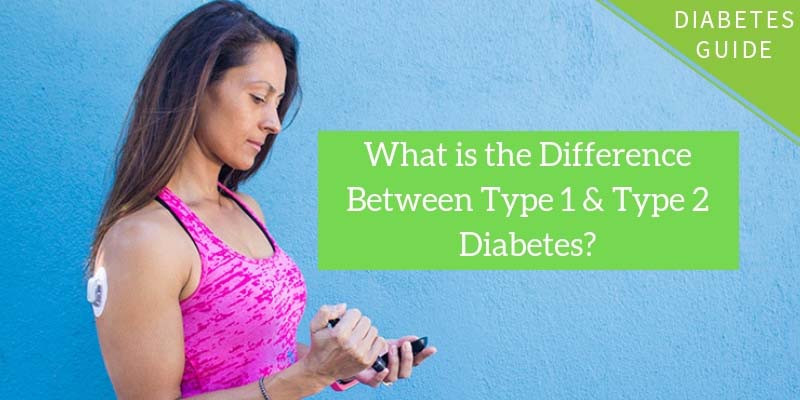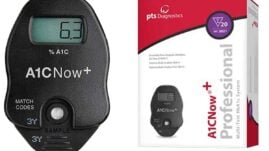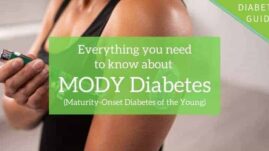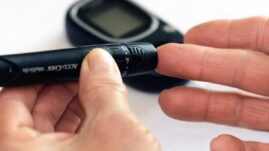While many of the symptoms and terminology may look the same, type 1 diabetes and type 2 diabetes are very different. The differences between these two types of diabetes are significant but easy to overlook.
In fact, nearly everything about type 1 versus type 2 diabetes is different including the way it develops, why it develops, how it’s treated, and how it’s managed on a daily basis.
In this article, we’ll look at the many differences between type 1 and type 2 diabetes while always remembering that both types are incredibly challenging and life-changing.

What causes type 1 and type 2 diabetes?
The cause of type 1 diabetes and type 2 diabetes and what’s happening inside the body as each type develops are wildly different. The symptoms and treatment options can be similar, but it’s actually two very different conditions.
Type 1 diabetes is an autoimmune disease
Type 1 diabetes is defined by the fact that the body is attacking itself. More specifically, the immune system has accidentally begun to attack and destroy the cells produced by the pancreas that are responsible for making insulin.
It’s common for the onset of type 1 diabetes to develop in the few weeks following a bout with an everyday virus like the flu or strep throat. While the body is attacking the virus, it begins to attack the healthy cells of the pancreas, too.
Research has also shown that people with type 1 diabetes produce inadequate amounts of amylin — another critical hormone that helps to regulate blood sugar levels and appetite after eating.
However, that doesn’t mean strep-throat or the flu caused type 1 diabetes. People with type 1 are likely born with a predisposition to someday develop the disease, and the everyday virus (or other stressful events like a car crash or even a divorce) is simply the catalyst for the onset.
While type 1s often like to joke that they need a new pancreas, what we really need is a smarter immune system — one that doesn’t constantly destroy the insulin-producing cells we need in order to stay alive. Every day, our pancreas continues to produce beta cells, and every day our immune system continues to destroy them.
While type 1 diabetes was originally called “juvenile diabetes”, it can actually develop in a person at any age. Currently, more than 50% of all new cases of type 1 diabetes occur in adults.
While there are numerous attempts to cure type 1 diabetes being studied at this time, there is currently no cure available. Instead, with the combination of a healthy diet, weight management, regular exercise, insulin, and other medications, type 1 diabetes can be managed healthfully for a full, long life!
Type 2 diabetes is a metabolic disorder
Contrary to what mainstream media often says, type 2 diabetes is not caused by eating too much sugar, or even by being overweight or obese either. Instead, the actual cause of type 2 diabetes is still a bit unknown.
While it’s clear that nutrition and bodyweight play a role in the development of type 2 diabetes and contribute significantly to insulin resistance, that still doesn’t address the cause of the condition.
What is clear, however, is that it is a dysfunction within the body’s ability to produce enough insulin, and the body’s ability to fully make use of the insulin produced.
Like type 1 diabetes, people with type 2 diabetes produce inadequate amounts of amylin — another critical hormone that helps to regulate blood sugar levels and appetite after eating.
A large percentage of patients with type 2 diabetes, explains Gretchen Becker, author of “The First Year: Type 2 Diabetes,” actually struggle to produce normal amounts of insulin, and this may start long before any other typical symptoms of diabetes or weight gain
Becker adds that the diabetes-related genes passed on through family members actually concern insulin production, not a disposition for insulin resistance.
Once considered a condition that only occurs with old age, type 2 diabetes can be diagnosed in children and teens, and adults of any age.
While there are numerous attempts to cure type 2 diabetes being studied at this time, there is currently no cure available. While “reversing diabetes” is a popular term, research has proven it to be rare. Instead, with the combination of a healthy diet, weight management, regular exercise, and medications, type 2 diabetes can be managed healthfully for a full, long life!
What are the symptoms of type 1 diabetes vs. type 2 diabetes?
The one area with the most commonalities in type 1 and type 2 diabetes are the symptoms because both conditions result in varying degrees of high blood sugar levels.
Symptoms of type 1 diabetes
The symptoms of type 1 diabetes come on much more quickly and severely because the development of the disease usually happens within a matter of weeks once the immune system has begun attacking the cells that produce insulin.
As insulin production quickly decreases, blood sugar levels quickly increase.
Left unnoticed or untreated, the dangerously high blood sugar levels within even one month of having the disease can become fatal or nearly fatal, putting undiagnosed patients in comas.
Fortunately, most cases of type 1 diabetes are caught before this happens due to its very consistent symptoms.
The most common symptoms of type 1 diabetes include:
- Sudden extreme thirst
- Abnormally frequent need to pee
- Abnormal fatigue and tiredness
- Unexplained weight-loss
- Blurred vision
- Yeast infections in women
- Dry bowel movements in diapers of young children
Symptoms of type 2 diabetes
For most people, the earliest stage of type 2 diabetes — prediabetes — goes unnoticed because its symptoms are not severe enough to warrant enough concern. However, it can be caught in its earliest stages if a doctor checks your HbA1c and fasting blood glucose levels.
The most common symptoms of type 2 diabetes include:
- Constantly thirsty
- Abnormally frequent need to pee
- Abnormal fatigue and tiredness
- Weight-gain
- Blurred vision
- Yeast infections in women
- Constant feeling of hunger
- Tingling pain or numbness in feet and hands
How are type 1 diabetes and type 2 diabetes diagnosed?
Despite very distinct symptoms, both types of diabetes can be mistaken for lingering flu symptoms or other ordinary illnesses that don’t require treatment. It’s crucial that anyone displaying signs of diabetes have their blood sugar levels tested and urine tested for ketones.
The following blood sugar and A1c results are used to diagnose prediabetes and type 2 diabetes.
Prediabetes
- HbA1c: 5.7 to 6.4 percent
- Fasting: 100 to 125 mg/dL
- 2 hours after a meal: 140 mg/dL to 199 mg/dL
Too often, patients diagnosed with prediabetes are simply sent home and given very little guidance on what they can do to prevent the further development of type 2 diabetes.
Consider your prediabetes diagnosis as a tremendous warning that type 2 diabetes is imminent unless you take action by making changes in your nutrition, body weight, and activity levels to help compensate for your body’s struggle to produce adequate insulin.
For some, losing weight and eating differently cannot prevent the development of type 2 diabetes, but for many, it can.
Type 2 diabetes
- HbA1c: 6.5 percent or higher
- Fasting: 126 mg/dL or higher
- 2 hours after a meal: 200 mg/dL or higher
Some patients diagnosed with type 2 diabetes can actually have type 1 diabetes. This mistake can happen in adults developing type 1 because many doctors aren’t aware of how common type 1 diabetes has become in adults.
If you’ve been diagnosed with type 2 and you suspect you actually have type 1, ask to have your autoantibody levels tested. This test will reveal if your body is struggling with an autoimmune form of diabetes versus a metabolic disorder.
Type 1 diabetes
- HbA1c: 6.5 percent or higher
- Fasting: 126 mg/dL or higher
- 2 hours after a meal: 200 mg/dL or higher
For patients with undiagnosed type 1 diabetes, blood sugar levels are often above 400 mg/dL before they’ve made a visit to the emergency room or primary care. If you do suspect that you or someone you know has type 1 diabetes, visit your primary care or urgent care immediately.
Be sure to ask for both your blood sugar level and your urine ketone level to be tested.
- Read more about ketones at diagnosis in Diabetes Strong’s guide to diabetes and ketones.
How are type 1 diabetes and type 2 diabetes treated?
Mainstream media would have you believe that treating diabetes is as easy as eating fewer doughnuts or slapping an insulin pump on and poof! Your diabetes is controlled now!
While all patients with type 1 diabetes need insulin to stay alive, there are a variety of treatment plans for people with type 2 diabetes depending on their body’s needs. No treatment plan is better or worse than another. Instead, the right choice for each patient is simply defined by what helps that patient improve their blood sugar levels.
In real life, treating any type of diabetes is a complicated, non-stop juggling act of variables including:
- insulin
- oral medications
- non-insulin injections
- exercise
- counting carbohydrates
- compensating for large amounts of dietary fat and protein
- adrenaline
- menstrual cycles
- growth hormones
- stress
- other health conditions
- human error
Let’s take a closer look at the “basics” of treating type 1 diabetes versus treating type 2 diabetes.
A1c goals for type 1 and type 2 diabetes
People living with type 1 or type 2 diabetes are all encouraged to achieve an HbA1c level at or below 7.0 percent for the best prevention of diabetes-related complications.
A crucial part of diabetes management for both type 1 and type 2 is testing your blood sugar. Using a glucometer or continuous glucose monitor each day is the only way to know if your choices around food, insulin, exercise, and other medications are keeping your blood sugar within a safe range.
For some people with diabetes — especially those who have “hypoglycemia unawareness” or the elderly — aiming for an A1c of 7.0 may present too much risk and stress.
Determining the right A1c goal for you based on your current diabetes management, your goals (like pregnancy), and other stressors in your life (like divorce, the death of a loved one, a sick child, etc.) can mean that tighter blood sugar management isn’t realistic.
Instead, focus on doing the best you can with an A1c goal that is realistically achievable and safe for your life at this time.
- Read more on how to lower your A1c in Diabetes Strong’s A1c Guide.
Insulin, Insulin Pumps, Insulin Pods
Every single person diagnosed with type 1 diabetes needs insulin via injection or pump in order to stay alive. People with type 1 diabetes may still produce a little bit of their own insulin, but it will not be enough to keep their body functioning.
Some people with type 2 diabetes need insulin while others do not. While we’ve been taught by magazines and news shows that diabetes can be “cured” with diet and exercise, that’s far from the truth.
For multiple daily injections: If you’re taking your insulin with a syringe or insulin pen, you will need a long-acting (basal) insulin that’s taken once or twice a day to replicate the way your pancreas would normally release a constant drip, drip, drip of insulin all day and all night long.
Then, you will need a fast-acting (or “rapid”) insulin for meals, and for corrections when your blood sugar is high. Fast-acting insulin replicates the way your pancreas would normally release a large bolus of insulin to manage the food you eat.
For insulin pumps or pods: People using pumps or pods to deliver their insulin will only use fast or rapid-acting insulin that you program with your healthcare team to deliver insulin that drip, drip, drip all day long as well as larger boluses of insulin for meals and corrections.
Continuous glucose monitors
Continuous glucose monitors (CGMs) are one of the newest forms of diabetes technology. By wearing a small sensor in the body fat on your belly, arm, or thigh, blood sugar levels are reported every 5 minutes to a receiver.
This technology gives many patients with type 1 diabetes far more peace of mind, increased safety during sleep and exercise, reductions in both high and low blood sugars, and the ability to manage blood sugars in a tighter range.
While CGMs are more commonly used in treating type 1 diabetes, some patients with type 2 diabetes taking insulin may benefit tremendously from using one.
Non-insulin diabetes medications: oral & injectable
People with type 1 diabetes can also take medications originally intended for type 2 diabetes that assist with insulin resistance, glucose released by the liver, and our body’s lack of the hormone amylin.
The list of non-insulin medications for people with diabetes is a long one, but here are a few of the most common: Metformin, Victoza, Symlin, Invokana, and Byetta.
- Find a lengthy, complete list of medications used to treat type 2 diabetes from UCSF.
Nutrition and diet
People with type 1 and type 2 diabetes can technically “eat anything” by counting the carbohydrates, taking insulin, and accounting for high quantities of fat or protein. However, for steadier blood sugar levels, the diabetes world is gradually accepting that a diet with fewer carbohydrates is very helpful.
By eating a whole-food diet that focuses on vegetables, proteins, and fats, with a reduction of starches, sugars, and even fruit, blood sugar levels become easier to manage because the need for insulin decreases when carbohydrate consumption decreases.
Whether you choose to reduce your carbohydrate consumption or not, there’s no debate that those of us with diabetes all benefit from eating a diet made up of mostly whole, real food.
Weight-loss and weight-management
Simply put, the healthier your overall body weight is, the less insulin resistance you’ll struggle with, and the healthier your entire body will be! Losing weight and maintaining a healthy weight is a key part of living well with type 1 and type 2 diabetes.
Losing weight with diabetes isn’t always easy. While it starts with making healthy food choices and exercising regularly, patients taking insulin and other medications that lower blood sugar need to be very careful.
Even if you lose 3 or 5 pounds, you’ll find your insulin and other medication needs will drop, too. If you don’t make changes to your medication dosages, you may experience severe low blood sugars. It’s important, especially for anyone taking insulin, to make these gradual adjustments as you gradually lose weight.
- Read more about weight loss in DiabetesStrong’s Guide to Losing Weight with Diabetes.
Exercise and other variables
The most complicated part of diabetes management is that it’s never-ending. Your blood sugars never stay in one place for long, because so many aspects of daily living and the normal functions of the human body will raise or lower your blood sugar levels and your insulin needs.
Even if you were to eat the same foods every single day, the other variables that impact the body’s blood sugar levels and insulin needs would require just as much attention each day.
Exercising, for example, with type 1 diabetes is remarkably complex. Simply changing the type of exercise and the time of day you perform that exercise will drastically change how you must prepare your blood sugar to prevent high or low blood sugars during and after your workout.
Read more about exercising with diabetes and insulin:
Which is worse: type 1 or type 2 diabetes?
Guess what? Living with any type of diabetes presents a variety of incredibly stressful challenges on a daily challenge. No type of diabetes is “easy,” and no type of diabetes is easily fixed with diet and exercise.
And most importantly, when left untreated, both types of diabetes can result in serious complications, which means all types of diabetes are serious.
At the end of the day, every person living with diabetes deserves compassion, respect, and understanding. All types can affect every single part of your life!
The most important thing to remember is that you are not defined by your blood sugars, and you do not need to manage diabetes perfectly to live a full life!




Feliza Brunt
I have had type 1 diabetes for about a year. I got the medicine prescription from Ongo Care (a telemedicine platform). I have a question here about type 2 diabetes, can it affect only metabolism, or can affect any other organ as well?
Christel Oerum
Elevated blood sugars can damage the whole body. You can learn more about Type 2 Diabetes here: https://diabetesstrong.com/category/diabetes/type-2/
Judy Harris
Need help with losing weight. I have type2 diabetes
Christel Oerum
I know this article says “Type 1” but the principles are the same for Type 2 diabetes. However, if you don’t use insulin just skip that part
https://diabetesstrong.com/how-to-lose-weight-when-you-live-with-diabetes/